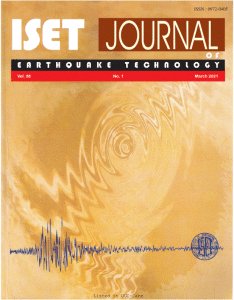Home > Issues & Journals
Seismic Response of Sliding Isolated Soft Story Building Using Velocity Dependent Friction Model
Rojalin Moharana and Sanjaya Kumar Patro
Paper No.: 545
|
Vol.: 56
|
No.: 3
|
September, 2019
|
pp. 75-91

Abstract
The effectiveness of sliding isolation systems for aseismic design has been established in recent past. Their design requires accurate prediction of hysteretic behavior of sliding surfaces using Coulomb friction, in which the coefficient of friction is constant. However, it is revealed by Yester researchers from experimental investigations that sliding materials show complex behavior of friction force, in both sliding and transition phases, which include the non-linear relationship between friction and sliding velocity. Buildings with soft stories at ground level are more vulnerable to seismic excitation. This paper has emphasized the influence of velocity-dependent friction behavior in the sliding isolation system using the Teflon steel interface to mitigate the seismic response of a soft-story building. The presence of soft-story increases the vulnerability towards the earthquake by producing large drift at the soft story level, which can be effectively reduced by using a Sliding isolation system. It concludes based on the results of time history and response spectra analysis that, by using the velocity-dependent friction model, it gives less seismic response than the Coulomb friction model, which has a constant coefficient of friction. Therefore, Coulomb’s constant-coefficient friction model may underestimate the usefulness of pure friction sliding isolation systems.
Keywords: Seismic Response; Pure Friction; Friction Model; Soft-Story Building; Sliding Base Isolation
©2025. ISET. All Rights Reserved.